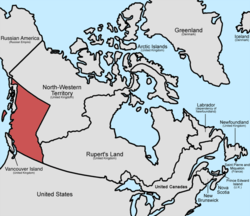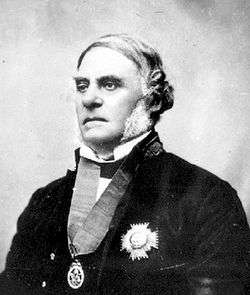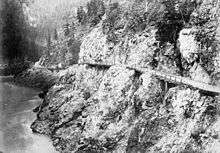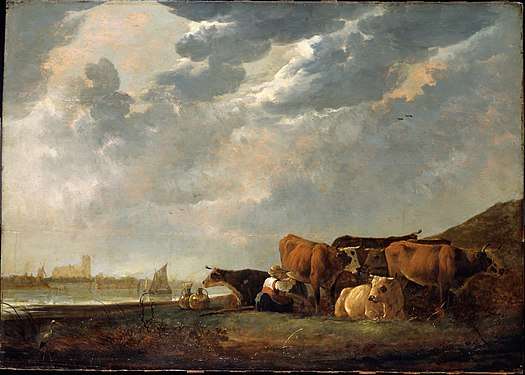Colony of British Columbia (1858–1866)
The Colony of British Columbia was a crown colony in British North America from 1858 until 1866. It was founded by the British Crown, who appointed James Douglas, then Governor of the neighbouring colony of Vancouver's Island (established in 1849) as the Colony's first Governor. Richard Clement Moody was the Colony's first Chief Commissioner of Lands and Works. At its creation, it physically constituted approximately half the present day Canadian province of British Columbia, since it did not include the Colony of Vancouver Island, the vast regions north of the Nass and Finlay Rivers, the regions east of the Rocky Mountains, or any of the coastal islands. The Colony of the Queen Charlotte Islands and the Stikine Territory were merged with it in 1863, and it was amalgamated in 1866 with the Colony of Vancouver Island to form a new Colony of British Columbia.
Colony of British Columbia | |||||||||||||||
|---|---|---|---|---|---|---|---|---|---|---|---|---|---|---|---|
| 1858–1866 | |||||||||||||||
 Flag | |||||||||||||||
 The Colony of British Columbia in 1863 | |||||||||||||||
| Status | British colony | ||||||||||||||
| Capital | Fort Langley (1858–1859) New Westminster (1859–1866) | ||||||||||||||
| Common languages | English (official) Northern Athabaskan languages Salishan languages | ||||||||||||||
| Religion | Christianity, Indigenous beliefs | ||||||||||||||
| Government | Constitutional monarchy | ||||||||||||||
| Queen regnant | |||||||||||||||
| Historical era | British Era | ||||||||||||||
• Established | 2 August 1858 | ||||||||||||||
• Merged with Colony of Vancouver Island to form Colony of British Columbia (1866-1871) | 6 August 1866 | ||||||||||||||
| Currency | Pound sterling (to 1865) British Columbia dollar (1865–66) | ||||||||||||||
| |||||||||||||||
Background
The explorations of James Cook and George Vancouver, and the concessions of Spain in 1794 established British claims over the coastal area north of California. Similar claims were established inland via the explorations of such men as John Finlay, Sir Alexander Mackenzie, Simon Fraser, Samuel Black, and David Thompson, and by the subsequent establishment of fur trading posts by the North West Company and the Hudson's Bay Company (HBC). However, until 1858, the region which now comprises the mainland of the Province of British Columbia was an unorganised area of British North America comprising two fur trading districts: New Caledonia, north of the Thompson River drainage; and the Columbia District, located south of the Thompson and throughout the basin of the Columbia River.

With the signing of the Treaty of Washington in 1846, which established the US border along the 49th parallel, the HBC moved the headquarters of its western operations from Fort Vancouver on the Columbia River (present day Vancouver, Washington) to the newly established Fort Victoria, on the southern tip of Vancouver Island. Vancouver Island and the surrounding Gulf Islands in the Strait of Georgia were organised as a crown colony in 1849. Meanwhile, the mainland continued to function under the de facto administration of the HBC, whose chief executive, James Douglas, also happened to be governor of Vancouver Island. The non-aboriginal mainland population during this time never exceeded about 150 at Fort Victoria,[1] mostly HBC employees and their families.
Governorship of James Douglas
By 1857, Americans and British were beginning to respond to rumors of gold in the Thompson River area. Almost overnight, some ten to twenty thousand men moved into the region around present-day Yale, British Columbia, sparking the Fraser Canyon Gold Rush. Governor Douglas - who had no legal authority over New Caledonia – stationed a gunboat at the entrance of the Fraser River to exert such authority by collecting licences from prospectors attempting to make their way upstream. To normalize its jurisdiction, and undercut any HBC claims to the resource wealth of the mainland, the district was converted to a Crown colony on 2 August 1858 by the Parliament of the United Kingdom, and given the name British Columbia. Douglas was offered the governorship of the new colony by the colonial secretary, Sir Edward Bulwer-Lytton, on condition that he sever his relationship with the HBC. Douglas accepted these conditions, and a knighthood.
The influx of people into the new colony required Douglas to act quickly in drawing up regulations and creating infrastructure. Magistrates and constables were hired, mining regulations drawn up, and town sites surveyed at Yale, Hope and Fort Langley to discourage squatting on crown land. In addition, roads were constructed into the areas of greatest mining exploration around Lillooet and Lytton. The colony, however, was not immediately granted a representative colonial assembly, because of uncertainty as to whether the gold rush would yield a stable, settled population. Douglas, who had endured unhappy conflicts with the assembly on Vancouver Island, was relieved.

The rush indeed was short lived, and the exodus of miners, speculators, and merchants was already underway by the time the Royal Engineers had laid out the colony's new capital at New Westminster. Prospecting continued, however, and additional finds farther inland in the Cariboo region in 1860 signalled an impending second gold rush. Provisioning was already proving to be an acute problem, and with more distant finds it became clear that wagon trains would have to replace pack horses, necessitating new infrastructure.
Throughout his tenure, Douglas was engaged in a bitter feud with Richard Clement Moody (see below).
Richard Clement Moody
Selection
When news of the Fraser Canyon Gold Rush reached London, Moody was hand-picked by the Colonial Office, under Sir Edward Bulwer-Lytton, to establish British order and to transform the newly established Colony of British Columbia (1858–66) into the British Empire's "bulwark in the farthest west"[2] and "found a second England on the shores of the Pacific".[3] Lytton desired to send to the colony "representatives of the best of British culture, not just a police force": he sought men who possessed "courtesy, high breeding and urbane knowledge of the world"[4] and he decided to send Moody, whom the Government considered to be the archetypal "English gentleman and British Officer"[5] at the head of the Royal Engineers, Columbia Detachment, which was created by an Act of the British Parliament on 2 August 1858. The Engineers were believed to exemplify the qualities sought by the Government.[6]
Moody and his family arrived in British Columbia in December 1858, commanding the Royal Engineers, Columbia Detachment. He was sworn in as the first Lieutenant-Governor of British Columbia and appointed Chief Commissioner of Lands and Works for British Columbia. On the advice of Lytton, Moody hired Robert Burnaby as his personal secretary, and the two became close friends. Moody's letter to his friend Arthur Blackwood Esq. at the Colonial Office, dated 1 February 1859, contains several passages of sublime poetical description that demonstrate the qualities for which he was preferred.[7][5]
The Detachment under Moody consisted of 150 sappers and officers. This was later and was later increased to 172. Moody had three Captains: Robert Mann Parsons, John Marshall Grant and Henry Reynolds Luard. The contingent included two subalterns, Lieutenant Arthur Lempriere (later a Major-General) and Lieutenant Henry Palmer, a surgeon, Dr John Vernon Seddall, Captain William Driscoll Gosset, a retired Royal Engineer, who served as civilian treasurer and commissary officer, Rev. John Sheepshanks served as the detachment's chaplain, and Burnaby.
Ned McGowan's War
Moody had hoped to begin immediately the foundation of a capital city, but upon his arrival at Fort Langley he learned of an outbreak of violence at the settlement of Hill's Bar. This led to an incident popularly known as "Ned McGowan's War", where Moody led 22 Engineers and Judge Matthew Baillie Begbie to Yale to face down a group of rebellious American miners. Order was restored without further violence. Moody describes the incident thus:
"The notorious Ned McGowan, of Californian celebrity at the head of a band of Yankee Rowdies defying the law! Every peaceable citizen frightened out of his wits!—Summons & warrants laughed to scorn! A Magistrate seized while on the Bench, & brought to the Rebel's camp, tried, condemned, & heavily fined! A man shot dead shortly before! Such a tale to welcome me at the close of a day of great enjoyment."[8]
He enjoyed a warm reception for his success that he describes thus: "They gave me a Salute, firing off their loaded Revolvers over my head—Pleasant—Balls whistling over one's head! as a compliment! Suppose a hand had dropped by accident! I stood up, & raised my cap & thanked them in the Queen's name for their loyal reception of me".[9]
The foundation of New Westminster
In British Columbia, Moody "wanted to build a city of beauty in the wilderness" and planned his city as an iconic visual metaphor for British dominance, "styled and located with the objective of reinforcing the authority of the Crown and of the robe".[10] Subsequent to the enactment of the Pre-emption Act of 1860, Moody settled the Lower Mainland. He selected the site and founded the new capital, New Westminster. He selected the site due to the strategic excellence of its position and the quality of its port.[10] He was also struck by the majestic beauty of the site, writing in his letter to Blackwood,
"The entrance to the Frazer is very striking--Extending miles to the right & left are low marsh lands (apparently of very rich qualities) & yet fr the Background of Superb Mountains-- Swiss in outline, dark in woods, grandly towering into the clouds there is a sublimity that deeply impresses you. Everything is large and magnificent, worthy of the entrance to the Queen of England's dominions on the Pacific mainland. [...] My imagination converted the silent marshes into Cuyp-like pictures of horses and cattle lazily fattening in rich meadows in a glowing sunset. [...] The water of the deep clear Frazer was of a glassy stillness, not a ripple before us, except when a fish rose to the surface or broods of wild ducks fluttered away".[7][11]

Moody designed the first Coat of arms of British Columbia.[12][13]
However, Lord Lytton "forgot the practicalities of paying for clearing and developing the site and the town" and the efforts of Moody's Engineers were continuous hampered by insufficient funds, which, together with the continuous opposition of Douglas, "made it impossible for [Moody's] design to be fulfilled".[14]
The feud between Moody and Governor James Douglas
Throughout his tenure in British Columbia, Richard Clement Moody was engaged in a bitter feud with Sir James Douglas, Governor of Vancouver Island, whose jurisdiction overlapped with his own. Moody's position as Chief Commissioner and Lieutenant-Governor was one of "higher prestige [and] lesser authority" than that of Douglas, despite Moody's vastly superior social position in the eyes of the Engineers and the British Government: Moody had been selected by Lord Lytton due to his possession of the quality of the "archetypal English gentleman and British Officer", his family was "eminently respectable": he was the son of Colonel Thomas Moody (1779-1849), one of the wealthiest mercantilists in the West Indies, who owned much of the land in the islands where Douglas's father owned a small amount of land and from which Douglas's mother, "a half-breed", originated. Governor Douglas's ethnicity made him "an affront to Victorian society".[15] Mary Moody, the descendant of the Hawks industrial dynasty and the Boyd merchant banking family,[16] wrote on 4 August 1859 "it is not pleasant to serve under a Hudson's Bay Factor" and that the "Governor and Richard can never get on".[17] In letter to the Colonial Office of 27 December 1858, Richard Clement Moody boasts that he had "entirely disarmed [Douglas] of all jealousy".[18] Douglas repeatedly insulted the Engineers by attempting to assume their command[19] and refusing to acknowledge their value in the nascent colony.[20]
Margaret A. Ormsby, author of the Dictionary of Canadian Biography entry for Moody (2002), condemns Moody for a contribution to the abortive development of the city. However, most other historians have exonerated Moody for the abortive development of the city and consider his achievement to be impressive, especially with regard to the perpetual insufficiency of funds and the personally motivated opposition of Douglas, whose opposition to the project continually retarded its development. Robert Edgar Cail,[21] Don W. Thomson,[22] Ishiguro, and Scott have praised Moody for his contribution, the latter accusing Ormsby of being "adamant in her dislike of Colonel Moody" despite the evidence,[23] and almost all biographies of Moody, including those of the Institute of Civil Engineers, the Royal Engineers, and the British Columbia Historical Association, are flattering.
Other developments
Moody and the Royal Engineers also built an extensive road network, including what would become Kingsway, connecting New Westminster to False Creek, the North Road between Port Moody and New Westminster, and the Cariboo Road and Stanley Park. He named Burnaby Lake after his private secretary Robert Burnaby and named Port Coquitlam's 400-foot "Mary Hill" after his wife. As part of the surveying effort, several tracts were designated "government reserves", which included Stanley Park as a military reserve (a strategic location in case of an American invasion). The Pre-emption act did not specify conditions for distributing the land, so large parcels were snapped up by speculators, including 3,750 acres (1,517 hectares) by Moody himself. For this he was criticized by local newspapermen for land grabbing. Port Moody is named after him. It was established at the end of a trail that connected New Westminster with Burrard Inlet to defend New Westminster from potential attack from the US.
By 1862, the Cariboo Gold Rush, attracting an additional 5000 miners, was underway, and Douglas hastened construction of the Great North Road (commonly known now as the Cariboo Wagon Road) up the Fraser Canyon to the prospecting region around Barkerville. By the time of this gold rush, the character of the colony was changing, as a more stable population of British colonists settled in the region, establishing businesses, opening sawmills, and engaging in fishing and agriculture. With this increased stability, objections to the colony's absentee governor and the lack of responsible government began to be vocalised, led by the influential editor of the New Westminster British Columbian and future Premier, John Robson. A series of petitions requesting an assembly were ignored by Douglas and the colonial office until Douglas was eased out of office in 1864. Finally the colony would have both an assembly and a resident governor.
Royal Engineers, Columbia Detachment was disbanded in July, 1863. The Moody family, only 22 men and 8 wives returned to England, while the rest, 130 sappers, elected to remain in BC.[12] Scott contends that the departure of the Engineers "doomed" the development of the settlement and the fruition of Lord Lytton's dream.[24] Chartres Brew replaced Moody as land commissioner.
Governorship of Frederick Seymour
Douglas's successor was Frederick Seymour, who came to the colony with twenty years of colonial experience in Van Diemen's Land, the British West Indies, and British Honduras. The creation of an assembly and Seymour's appointment in April 1864 signalled a new era for the colony, now out of the shadow of Vancouver Island and free of a governor suspicious of sharing power with elected representatives. Douglas's wagon road project was still underway, presenting huge engineering challenges, as it made its way up the narrow Fraser Canyon. Successive loans authorised by Seymour's predecessor, largely for the purpose of completing the road, had put the colony £200,000 in debt; and the Chilcotin War of 1864 cost an additional £18,000 to suppress. Seymour himself made the difficult journey through the Great Canyon of the Homathko and Rainbow Range as a show of force and participation in the hunt for Klatsassin, the Tsilhqot'in war leader, but the armed expedition reached a denouement when Klatsassin surrendered on terms of amnesty in times of war, only to be tried and hanged for murder, as Seymour had not endorsed the terms.
On Seymour's return overland, he made a tour of the Cariboo minefields, and along the Fraser Canyon, which made him increasingly convinced of the colony's future prosperity. On returning to the capital, however, fiscal reality set in as it became clear that British Columbia's indebtedness was getting worse. Even as the colonial administration took drastic measures to augment revenues and improve the road system to attract prospectors and settlers, the economic situation grew increasingly dire, and agitation grew for an amalgamation of the two colonies. Seymour opposed this proposal, but with pressure from various quarters of the colonial government, he eventually relented, recommending that British Columbia be the dominant partner, and (unsuccessfully) that the capital be located at New Westminster. The two colonies were united by an Act of the British Parliament, and proclaimed on 6 August 1866 (see Colony of British Columbia (1866-1871)).
Governors
- Sir James Douglas, 1858–1864
- Frederick Seymour, 1864–1866
Colonial Assembly
Members 1863–1864[25]
- Arthur Nonus Birch, Colonial Secretary and Presiding Member
- Henry Pering Pellew Crease, Attorney General
- Wymond Ogilvy Hamley, Collector of Customs
- Chartres Brew, Magistrate. New Westminster
- Peter O'Reilly, Magistrate Cariboo East
- E.H. Sanders, Magistrate, Yale
- Henry Maynard Ball, Magistrate, Lytton
- Philip Henry Nind, Magistrate, Douglas
- Joshua Homer, New Westminster District
- Robert Thompson Smith, Yale and Lytton District
- Henry Holbrook, Douglas and Lillooet District
- James Orr, Cariboo East District
- Walter Shaw Black, Cariboo West District
Members 1864–1865[26]
- Arthur Nonus Birch, Colonial Secretary and Presiding Member
- Henry Pering Pellew Crease, Attorney General
- Charles William Franks, Treasurer
- Wymond Ogilvy Hamley, Collector of Customs
- Chartres Brew, Magistrate. New Westminster
- Peter O'Reilly, Magistrate Cariboo
- Henry Maynard Ball, Magistrate, Lytton
- Andrew Charles Elliott, Magistrate, Lillooet
- John Carmichael Haynes, Magistrate, Osoyoos and Kootenay
- Joshua Homer, New Westminster District
- Clement Francis Cornwall, Hope, Yale and Lytton District
- Henry Holbrook, Douglas and Lillooet District
- George Anthony Walkem, Cariboo East and Quesnel Forks District
- Walter Moberly, Cariboo West and Quesnelmouth District
Members 1866[27]
- Henry Maynard Ball, Acting Colonial Secretary and Presiding Member
- Henry Pering Pellew Crease, Attorney General
- Charles William Franks, Treasurer
- Joseph Trutch Chief Commissioner of Lands and Works and Surveyor General
- Wymond Ogilvy Hamley, Collector of Customs
- Chartres Brew, Magistrate. New Westminster
- Peter O'Reilly, Magistrate Kootenay
- Andrew Charles Elliott, Magistrate, Lillooet
- John Carmichael Haynes, Magistrate, Osoyoos and Kootenay
- Joshua Homer, New Westminster District
- Clement Francis Cornwall, Hope, Yale and Lytton District
- Henry Holbrook, Douglas and Lillooet District
- George Anthony Walkem, Cariboo East and Quesnel Forks District
- Robert Smith, Cariboo West and Quesnelmouth District
Supreme Court
In 1858 the British Government sent over Matthew Baillie Begbie as Chief Justice for the colony. Although trained at Lincoln's Inn he had never practised law, but soon published a Rules of Court and a timetable of sittings. He held the post, under consecutive administrative regimes, until his death in 1894.[28]
See also
References
- Dunae, Patrick A.; Forward, C.N.; Newcomb, John (15 February 2017) [18 October 2011]. "Victoria (BC)". The Canadian Encyclopedia (online ed.). Historica Canada.
- Hauka, Donald J. (2003). McGowan's War. New Star Books. p. 146. ISBN 978-1-55420-001-6.
- Barman, Jean (2007). The West Beyond the West: A History of British Columbia. University of Toronto Press. p. 71. ISBN 978-1-4426-9184-1.
- Scott (1983), p. 13.
- Scott (1983), p. 19.
- Scott (1983), pp. 7–27.
- Moody (1951), pp. 85–107.
- Moody (1951), p. 95.
- Moody (1951), p. 97.
- Scott (1983), p. 26.
- Barman, Jean (2007). The West Beyond the West: A History of British Columbia. University of Toronto Press. p. 7. ISBN 978-1-4426-9184-1.
- Ormsby, Margaret A. (1982). "Moody, Richard Clement". In Halpenny, Francess G (ed.). Dictionary of Canadian Biography. XI (1881–1890) (online ed.). University of Toronto Press.
- "Heraldic Science Héraldique, Arms and Devices of Provinces and Territories, British Columbia". Retrieved 3 November 2016.
- Scott (1983), p. 27.
- Scott (1983), pp. 19-20.
- Howard, Joseph Jackson; Crisp, Frederick Arthur, eds. (1900). "Boyd of Moor House, Co. Durham". Visitation of England and Wales. 8. pp. 161–164.
- Scott (1983), p. 23.
- Scott (1983), p. 25.
- Scott (1983), p. 109.
- Scott (1983), pp. 115–117.
- Cail, Robert Edgar (1974). Land, Man, and the Law: The Disposal of Crown Lands in British Columbia, 1871-1913. University of British Columbia Press. p. 60. ISBN 978-0-7748-0029-7.
- Thomson, Don W. (1966). Men and Meridians: The History of Surveying and Mapping in Canada. Queen's printer. p. 282.
- Scott (1983), p. 131.
- Scott (1983), p. 137.
- "Journals of the Legislative Council of the Colony of British Columbia 21 January 1864 to 4 May 1864". Archived from the original on 13 May 2013.
- "Journals of the Legislative Council of the Colony of British Columbia from the 12th December 1864, to the 11th April, 1865". Archived from the original on 12 May 2013.
- "Journals of the Legislative Council of the Colony of British Columbia from the 18th January, to the 5th April, 1866". Archived from the original on 13 May 2013.
- Duhaime, Lloyd (26 September 2012). "Wild, Wild West Law". lawMAG.
Sources
- "The Photographic Album of Richard Clement Moody, Royal British Columbia Museum" (PDF).
- "Col. Richard Clement Moody". Retrieved 4 July 2016.
- "Letters of Mary Moody, Royal British Columbia Museum Archives" (PDF). Retrieved 4 July 2016.
- Minutes of the Proceedings of the Institution of Civil Engineers, Volume 90, Issue 1887, 1887, pp. 453-455, OBITUARY. MAJOR-GENERAL RICHARD CLEMENT MOODY, R.E., 1813-1181.
- Cleall, Esme; Ishiguro, Laura; Manktelow, Emily J. (Spring 2013). "Imperial Relations: Histories of family in the British Empire". Journal of Colonialism and Colonial History. 14 (1). doi:10.1353/cch.2013.0006.
- Francis, Daniel, ed. (1999). Encyclopedia of British Columbia. Harbour Publishing. ISBN 1-55017-200-X.
- Hayes, Derek (2005). Historical Atlas of Vancouver and the Lower Fraser Valley. Douglas & McIntyre. pp. 26–29. ISBN 978-1-55365-283-0.
- Moody, Richard Clement (January 1951). Willard E. Ireland (ed.). "Letter of Colonel Richard Clement Moody, R.E., to Arthur Blackwood, February 1, 1859". British Columbia Historical Quarterly. XV (1 & 2): 85–107.CS1 maint: ref=harv (link)
- Morton, Arthur S. (1973) [1939]. A History of the Canadian West to 1870-71, Second Edition. University of Toronto Press. p. 775f. ISBN 0-8020-0253-6.
- Scott, Laura Elaine (1983). The Imposition of British Culture as Portrayed in the New Westminster Capital Plan of 1859 to 1862 (PDF) (M.A. thesis). Simon Fraser University.CS1 maint: ref=harv (link)
- Sweetman, John. "Moody, Richard Clement". Oxford Dictionary of National Biography (online ed.). Oxford University Press. doi:10.1093/ref:odnb/19085. (Subscription or UK public library membership required.)
Further reading
- Ormsby, Margaret A. (1972). "Douglas, Sir James". In Hayne, David (ed.). Dictionary of Canadian Biography. X (1871–1880) (online ed.). University of Toronto Press.
- Ormsby, Margaret A. (1976). "Seymour, Frederick". In Halpenny, Francess G (ed.). Dictionary of Canadian Biography. IX (1861–1870) (online ed.). University of Toronto Press.